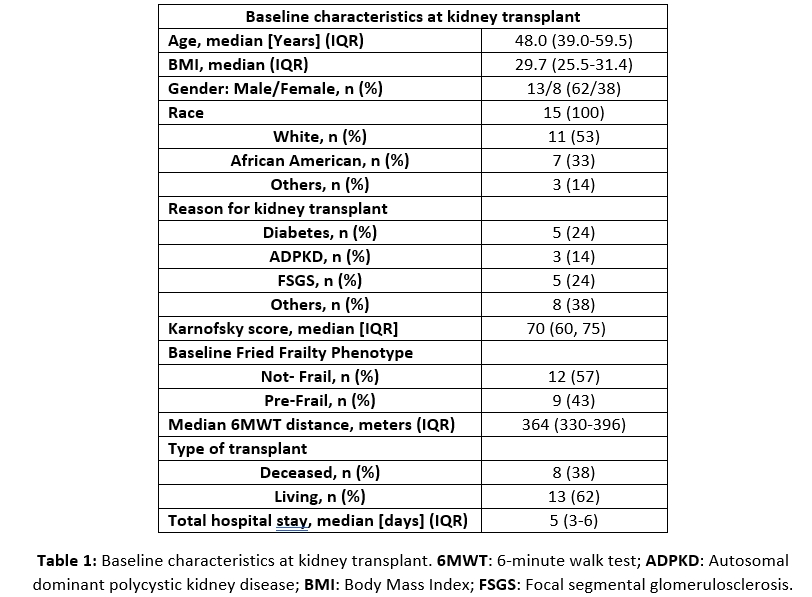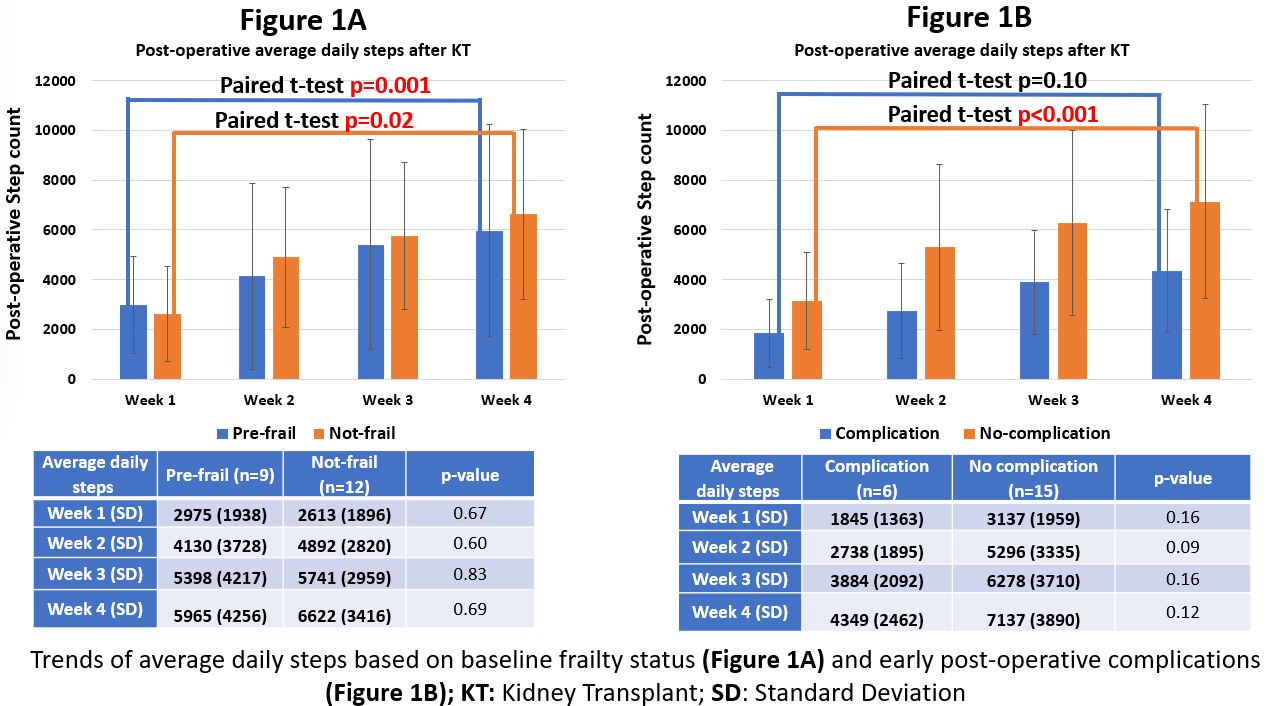Measurement of Physical Activity and Frailty in the Early Post-Operative Period After Kidney Transplant-Single-Center Prospective Pilot Study Using Fitbit Watch
T. Shamaa, L. Allenspach, O. Shamaa, S. Shimada, C. Crombez, O. Hage-Hassan, T. Kitajima, S. Yeddula, I. Bajjoka, L. Malinzak, J. Denny, D. Kim, M. Abouljoud, S. Nagai
Henry Ford Transplant Institute, Detroit, MI
Meeting: 2022 American Transplant Congress
Abstract number: 1361
Keywords: Kidney, Kidney transplantation, Monitoring, Morbidity
Topic: Clinical Science » Kidney » 33 - Kidney Psychosocial
Session Information
Session Time: 7:00pm-8:00pm
 Presentation Time: 7:00pm-8:00pm
Presentation Time: 7:00pm-8:00pm
Location: Hynes Halls C & D
*Purpose: Physical activity monitors (PAMs) allow patients to track multiple health parameters. PAM’s may be helpful to assess a patient’s physical recovery after a Kidney transplant (KT). We performed a pilot study to quantify early postoperative physical activity after KT.
*Methods: 35 Adult KT candidates were enrolled prospectively since February 2021 and provided with PAM (Fitbit® Inspire 2) for the first 30 days after KT. Patients who didn’t speak English and underwent multi-organ transplants were excluded. The following frailty tests were performed prior to KT and on postoperative day 30: Fried Frailty Phenotype, and 6-minute walk test. Biophysical data obtained through PAM included daily steps, and sedentary minutes.
*Results: 21 patients with complete frailty and PAM data were included in the final cohort with baseline characteristics shown in Table 1. Mean daily steps during the KT admission and POD 1-30 days were 1709 steps (Standard Deviation [SD]:1176) and 4581 (SD:2840) respectively. There was a significant difference in the average daily steps during the 1st week compared to the 4th week after KT (Week 1: 2768 [SD:1874] steps vs. Week 4: 6341 [SD:3712] steps, p<0.001). The number of sedentary minutes during the first 30 days after KT correlated negatively with the patient’s pre-KT Karnofsky score (r -0.54, p=0.012). There was no difference in the average daily steps between pre-frail and non-frail patients [Figure 1A]. There was a trend towards lower average daily steps for patients who experienced complications during the first 30 days after KT (Clavien grade 1-3: n=6) compared to those who didn’t (Complication: 5611 steps [SD:2973] vs. no-complication 3237 steps [SD:1639]; p=0.09). In addition, patients who had a complication failed to increase their daily steps at week 4 compared to week 1 (Paired t-test, p=0.10) [Figure 1B].
*Conclusions: PAM effectively captures post-operative biophysical parameters and can be successfully implemented to monitor a patient’s recovery after KT.
To cite this abstract in AMA style:
Shamaa T, Allenspach L, Shamaa O, Shimada S, Crombez C, Hage-Hassan O, Kitajima T, Yeddula S, Bajjoka I, Malinzak L, Denny J, Kim D, Abouljoud M, Nagai S. Measurement of Physical Activity and Frailty in the Early Post-Operative Period After Kidney Transplant-Single-Center Prospective Pilot Study Using Fitbit Watch [abstract]. Am J Transplant. 2022; 22 (suppl 3). https://atcmeetingabstracts.com/abstract/measurement-of-physical-activity-and-frailty-in-the-early-post-operative-period-after-kidney-transplant-single-center-prospective-pilot-study-using-fitbit-watch/. Accessed December 17, 2025.« Back to 2022 American Transplant Congress


